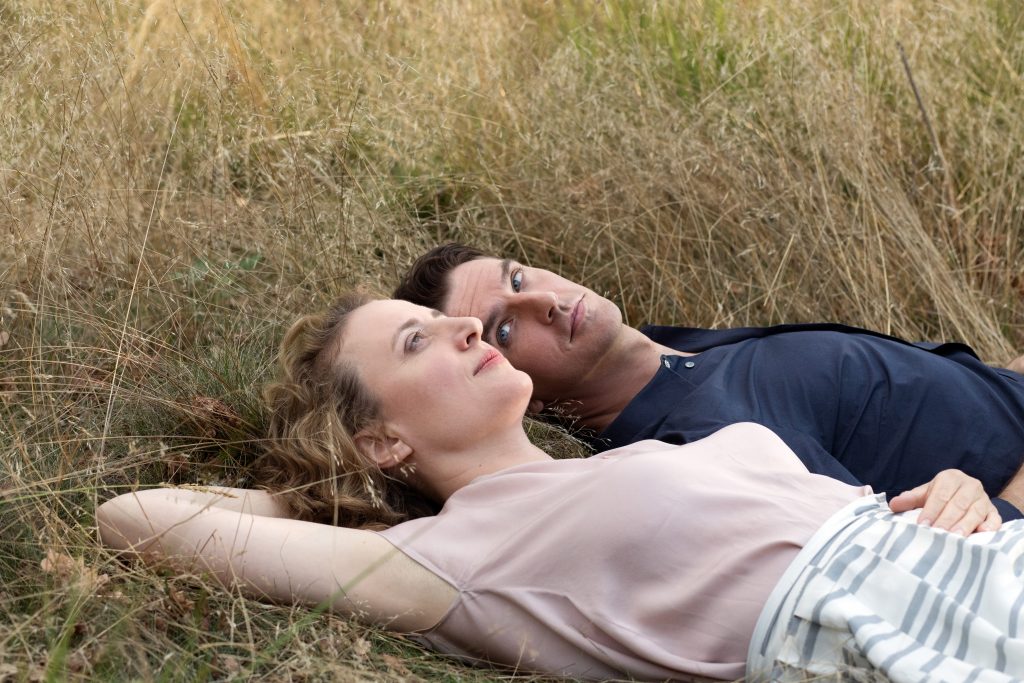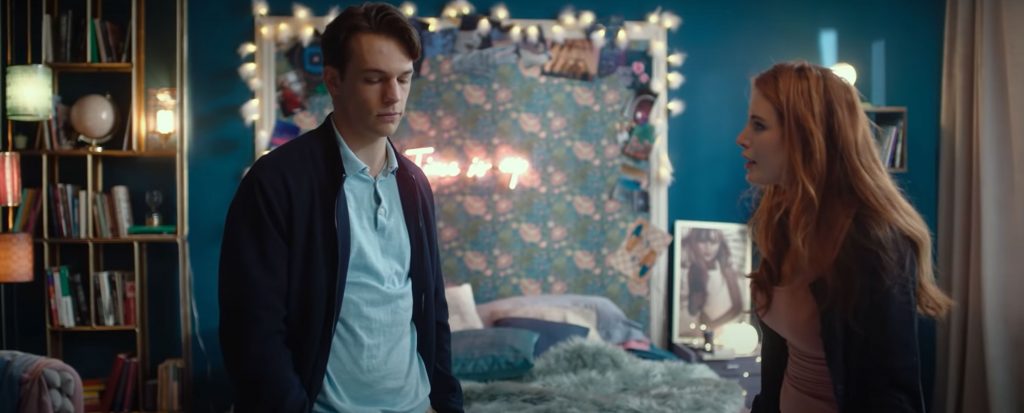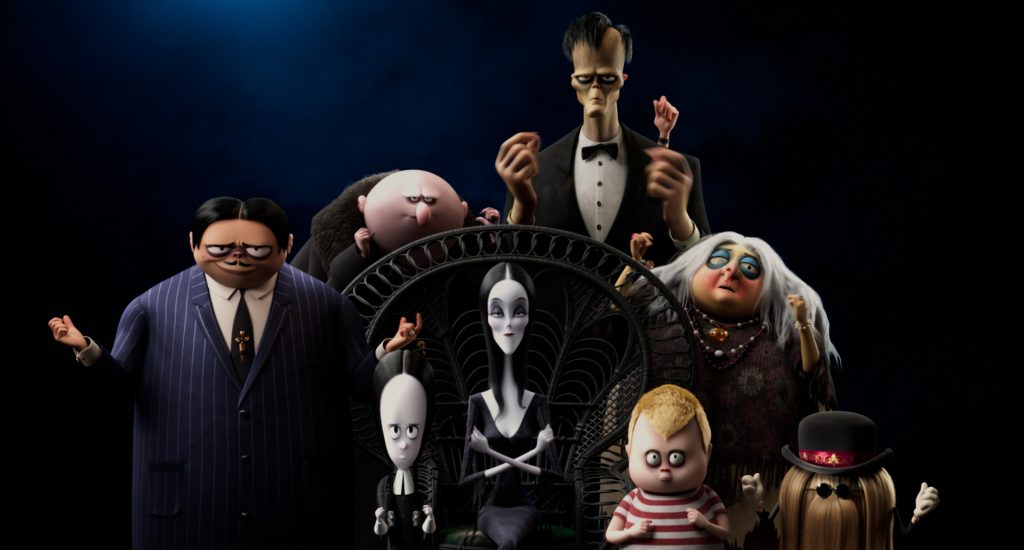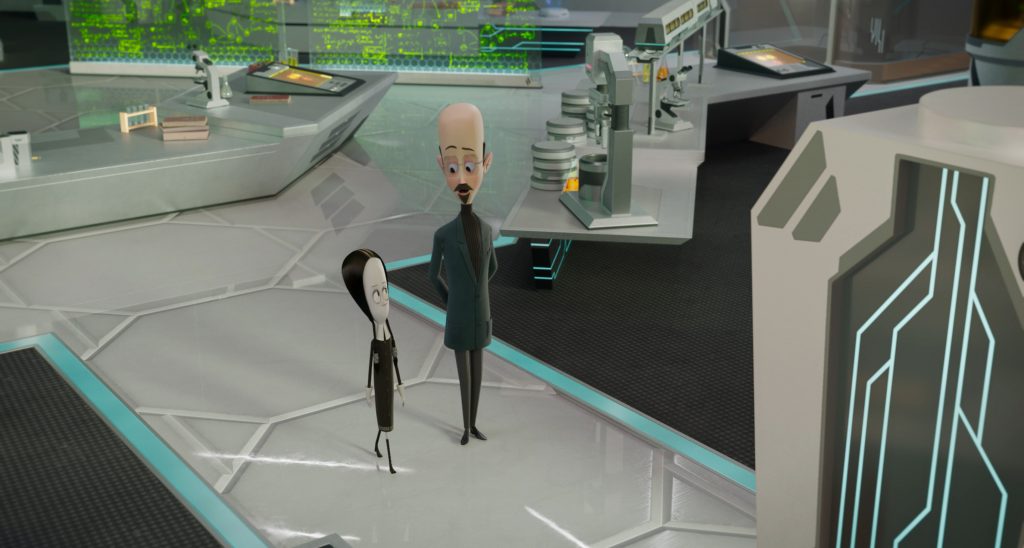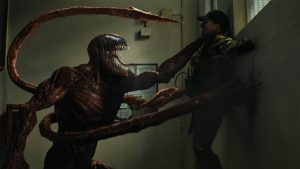October 7, 2021
by Carla Hay
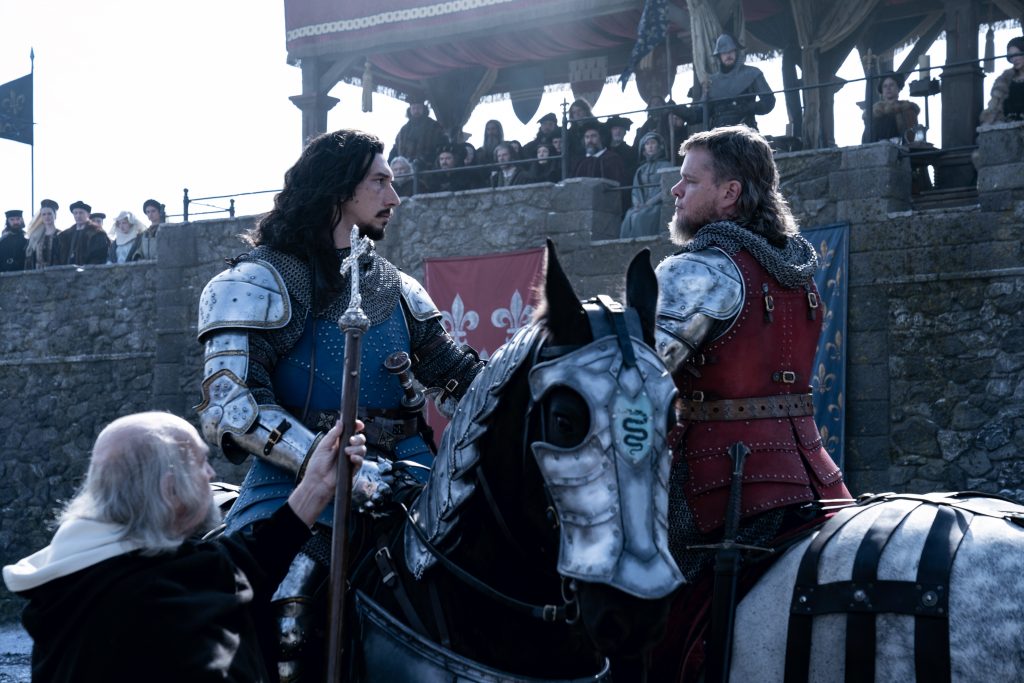
Directed by Ridley Scott
Culture Representation: Taking place in France from the years 1377 to the late 1380s, the dramatic film “The Last Duel” features an all-white cast of characters representing the working-class, middle-class and royalty.
Culture Clash: Two former friends, who fought battles together in the French military, face off in a violent duel after one of the men is accused of raping the other man’s wife.
Culture Audience: “The Last Duel” will appeal primarily to people who are interested in violent medieval-era dramas where some of the acting and dialogue are too modern be considered authentic, and sadistic machismo is put on the highest pedestal.

When watching “The Last Duel,” it might be annoying or amusing to see Matt Damon in a mullet, as he fumbles attempts to be a medieval Frenchman, by having a modern British-American accent. Ultimately, the movie has nothing new or insightful to say about violent machismo. If you really need to see the same rape of a woman depicted twice in a movie, just for the sake of showing the rape from the perspectives of the rapist and the victim, then “The Last Duel” is your kind of movie.
Directed by Ridley Scott, “The Last Duel” is written by Damon, Ben Affleck and Nicole Holofcener. They adapted the movie’s screenplay from Eric Jager’s 2004 book of the same name. Scott, Damon, Affleck and Holofcener are among the producers of “The Last Duel” movie. All of them have considerable talent, but all of them have made much better movies than “The Last Duel.”
It’s worth noting that “The Last Duel” is the first movie screenplay that Damon and Affleck have written together since their Oscar-winning original screenplay for 1997’s “Good Will Hunting,” a better-quality film about masculine identity. (Damon and Affleck also co-starred in “Good Will Hunting.”) “The Last Duel” certainly has the top-notch production design and cinematography that viewers have come to expect when Scott does a period movie, but it’s no “Gladiator.” In addition, “The Last Duel” has too much subpar acting from Affleck and cringeworthy dialogue in several parts of the movie for “The Last Duel” to be an Oscar-caliber film.
People familiar with the medieval era already know it was a brutal and violent period in history, when women were treated as nothing more than property to be bought and sold for marriage, with husbands having the legal right to “own” their wives. All of that misogyny is accurately depicted in “The Last Duel.” The problem is that the movie has a tone of a little too much enthusiasm when showing hatred and degradation of women.
It’s as if the filmmakers felt that just by having the movie take place during this ancient era, it was enough of a reason to show this misogyny so gratuitously. Any attempt to show any female character with some kind of inner strength is rushed in the last third of the film. This half-hearted nod to female empowerment doesn’t come across as genuine but rather it seems manipulative. It’s the equivalent of filmmakers putting a little dab of cleaner on the avalanche of dirty, sexist muck that’s poured all over the film.
Based on true events, “The Last Duel” takes place in France (mostly in Paris) from 1377 to the late 1380s. But if you were to believe this movie, women couldn’t possibly be as smart or as powerful as men. It completely refuses to acknowledge that women had positions of power and minds of their own in France during the medieval era—most notably Eleanor of Aquitaine, who was a leader more than 200 years before this story takes place. “The Last Duel” is so insistent on shutting out any depictions of intelligent women in power (even if it’s power in their own households) that when Queen Isabeau (played by Serena Kennedy) appears in the movie, she doesn’t have any lines of dialogue and is just there as a spectator sitting next to her king husband (who does talk) during the jousting match that is the movie’s namesake.
“The Last Duel,” is told in three chapters, each from the perspective of the three people involved in a rape case that is the reason for this jousting duel:
- Jean de Carrouges (played by Damon) is a domineering, middle-aged knight, who has fought many battles in the Crusades. He has the scars on his face and the rest of his body to prove it. Jean’s first wife and son died during the bubonic plague known as the Black Death. His second marriage is to a woman who is the story’s rape victim.
- Jacques Le Gris (played by Adam Driver), a roguish playboy who’s about 10 years younger than Jean, has risen through the military ranks to become a captain. Jacques is a never-married bachelor who has never had a committed love relationship.
- Marguerite de Carrouges (played by Jodie Comer), Jean’s second wife, is about 20 years younger than Jean. She comes from a well-to-do family that has fallen on hard times because her scandal-plagued father has been branded as a traitor. Marguerite accuses Jacques of raping her.
Each of the movie’s chapters is titled “Part One: The Truth According to Jean de Carrouges,” “Part Two: The Truth According to Jacque Le Gris” and “Part Three: The Truth According to Marguerite de Carrouges.” Unlike Showtime’s 2014-2019 drama series “The Affair,” “The Last Duel” doesn’t have wildly different memories of the same incidents from the three people involved in a love triangle. The memories and perspectives do have some differences, but they add up to a generally consistent overview of what life was like for the three people who are at the center of the rape case.
Someone who can influence the outcome of the rape case is the hard-partying Pierre d’Alençon (played by Affleck), who is the presiding judge and a close ally of Jacques. Pierre is also the much-older cousin of King Charles IV (played by Alex Lawther), who is portrayed as a brat in his 20s who doesn’t have the maturity to be an effective leader, but he’s tolerated by people around him because he inherited the title of king.
One of the biggest problems with “The Last Duel” is that it’s filled with modern lines of dialogue that sound like they’re straight out of a foul-mouthed movie written by Quentin Tarantino. Certain people, especially Pierre, like to say the words “fuck” or “fucking” a lot. That doesn’t mean that cursing didn’t exist in the medieval era, but the way the words are used in a contemporary-sounding dialogue context is just not accurate for those times.
And it doesn’t help that Affleck and Damon (who are both American) struggle with their fake European accents. Damon has entire scenes where he sounds American and British every time he talks. Driver (who is American) does a much better job at having a European-sounding accent, while Comer doesn’t have to pretend at all, since she’s British in real life.
For a movie that’s supposed to take place in France, it’s kind of pathetic that there are very few French people in “The Last Duel” cast, and none of these French actors has a large role in the film. (“The Last Duel” was actually filmed in Ireland.) This lack of significant French representation in the movie’s cast is an indication that “The Last Duel” director Scott (who is British) has an ethnic bias when it comes to who he wants in his movies. It’s also obvious that he didn’t care about having accurate language consistency for “The Last Duel” characters, since the stars of the movie sound British and American instead of French.
And in case anyone mistakenly thinks “The Last Duel” is a prestigious, Oscar-caliber film, think again. The movie goes into borderline softcore porn territory. Under Scott’s direction, “The Last Duel” seems enamored with showing in more than one tacky scene that Pierre and Jacques regularly participated in orgies together with willing women. One of the orgy scenes has a very “male gaze” to it, because it lingers on three women on a bed having sex with each other, while they wait for Pierre to join them. It’s such a predictable stereotype in these types of movie orgy scenes that same-sex hookups always comes from the women, not from the men.
Pierre is married with eight children, but he seems to think his family life just gets in the way of his sex parties. He even started to have an orgy in front of his pregnant wife Lady Marie Chamaillart (played by Zoé Bruneau), who seems to know what’s about to happen and quickly leaves the room. After having this orgy, Jacques asks Pierre if he wants to spend time with his wife. Pierre scoffs at the idea and says that Marie is “pregnant and hysterical. I’d rather take my chances with the wolves.”
This 152-minute movie plods along in showing Jean’s transactional marriage to Marguerite, whom he hopes will bear him a son so that he can have a male heir again. Jean drove a hard bargain for Marguerite’s dowry, by convincing Marguerite’s disgraced and financially desperate father Sir Robert de Thibouville (played by Nathaniel Parker) to give him a coveted strip of land as part of the deal. Sir Robert reluctantly agrees.
Jean is very patriotic and proud to serve in the military. Jacques becomes a close companion of his during their military battles, and Jean even saves Jacques’ life on one occasion. When Jean is not away from home for war duties, his occupation is being a landlord, but the Black Death caused many of his tenants to die, so he’s been struggling financially and is heavily in debt. Pierre later takes advantage of Jean’s financial woes when Pierre decides that Jean has become his enemy.
Marguerite handles the landlord transactions when Jean is away from home, and she finds out that he’s been an irresponsible business manager by not bothering to collect rent when he was supposed to do it. However, Marguerite is in the type of marriage where she can’t really speak up and point out these mistakes to Jean because his huge ego would just dismiss her concerns. She is constantly reminded by people in society that she should not speak up about problems that would be considered “embarrassing” or “disobedient” to her husband or other men.
Jacques and Marguerite meet at an outdoor party, where Jean introduces his new wife to his friend and tells Marguerite to give a friendly kiss to Jacques. Marguerite ends up kissing Jacques on the lips, and he looks at her in a way that shows it’s attraction at first sight, with that kiss causing some kind of spark in him. Marguerite admits to some of her female friends at the party that she thinks Jacques is handsome, but she doesn’t trust him because of his “bad boy” reputation.
Marguerite is well-read, while Jean is illiterate. In more than one scene in the film, Jacques and some other people express surprise that Jean allows Marguerite to read books. Jacques uses this information to his advantage when, shortly after he meets Marguerite, he flirts with her and tries to impress her with his knowledge of literature.
Later, it becomes clear that Jacques’ lust for Marguerite has turned into obsession, although he claims several times that he’s deeply in love with Marguerite and it’s the first time that he’s ever felt this way. It doesn’t justify him raping her. The movie leaves no ambiguity that this rape did occur.
Up until the rape (which is depicted in a disturbing way that might be too upsetting for sensitive viewers), “The Last Duel” becomes a soap opera filled with clichés that you might find in a cheap and tawdry romance novel. There’s the pretty housewife who’s lonely and bored because her husband is away from home a lot. And when he’s at home, their sex life is passionless and he doesn’t seem to care about what her needs are.
There’s the workaholic husband who’s so preoccupied with his work and self-image that he doesn’t see how unhappy his wife is. He thinks that all he needs to be a good husband is to be a good provider. He’s also annoyed with his wife because she hasn’t gotten pregnant as quickly as he wanted. After five years of marriage, she still hasn’t conceived a child.
There’s the tall, dark “bad boy” who’s just waiting for the right moment to “seduce” the lonely wife. The fact that the husband used to be the bad boy’s best friend makes the bad boy’s lust for the wife even more taboo. Driver is perfectly adequate in this villain role, but he’s limited by this two-dimensional character, and therefore it’s not an outstanding performance.
Also part of this parade of soap opera clichés is the bad boy’s “wingman”/sidekick, who gleefully helps with the scheming because he wants to cause some chaos too. In “The Last Duel,” the “wingman” character is named Adam Louvel (played by Adam Nagaitis), and he plays a pivotal role in Jacques’ planning of the rape. Just like Jacques, he’s a shallow character with no backstory.
The extra strip of land that Jean was promised as part of Marguerite’s dowry becomes the subject of a legal dispute when Jacques, in an effort to impress Pierre, seizes the land and hands it over to Pierre. It results in a messy lawsuit, with Jean suing Pierre and Jacques. Pierre grows increasingly alienated from and irritated with Jean because of this legal dispute. Meanwhile, Jacques tries to put the lawsuit behind him and makes the first move to repair his broken friendship with Jean.
However, any attempts for Jean and Jacques to become friends again get obliterated when the rape happens. “The Last Duel” gives harsh but realistic depictions of the victim blaming and victim shaming that rape survivors experience when they come forward and try to get justice for this crime. Complicating matters, Jacques admits that he had a sexual encounter with Marguerite, but he says it was consensual. He vehemently denies that it was rape. For many people who hear about Marguerite’s accusation, it’s a “he said/she said” situation.
The movie shows in chilling details how victim blaming/shaming reactions to a rape story are universal and timeless and don’t just come from men. Jean’s mother Nicole de Carrouges (played by Harriet Walter) believes Marguerite, but she scolds Marguerite for not keeping quiet about the rape. Meanwhile, Marguerite’s best friend Marie (played by Tallulah Haddon) doubts Marguerite’s accusation, because Marie thinks Marguerite was attracted to Jacques and that Marguerite might have done something to make Jacques think she was willing to have sex with him.
In her depiction of Marguerite, Comer gives an admirable performance of a woman who often has to suppress her emotions, out of fear of being labeled as a “hysterical” wife who might embarrass her husband. Through tearful eyes that still show steely determination, she achieves a balance of being emotionally vulnerable but mentally strong. Marguerite is going to need that inner strength when she gets an onslaught of criticism from many people because she went public with this accusation.
Marguerite tells Jean about the rape before they decide to go public with this accusation. Jean’s initial reaction isn’t to comfort Marguerite but to get angry that Jacques has betrayed him again. Jean eventually takes Marguerite’s side, but he’s motivated more by defending his own honor and reputation than defending Marguerite’s. Because it’s not spoiler information that “The Last Duel” is about Jean and Jacques’ jousting showdown about the rape, the movie just becomes scene after scene that builds up to this battle. Marguerite’s feelings and trauma get pushed to the side, while the movie ultimately gives more importance to the feuding between Jean and Jacques.
Although the movie shows Marguerite’s considerable bravery, it’s Jean who’s supposed to be the “hero” of the story for defending his wife. We know this because the viewer catharsis in the movie is supposed to come mainly from the jousting battle, which centers “The Last Duel” back on the men. The movie ends with scenes showing Marguerite, but make no mistake: “The Last Duel” is very much a movie about egotistical men and the violence they commit to get what they want.
20th Century Studios will release “The Last Duel” in U.S. cinemas on October 15, 2021.



